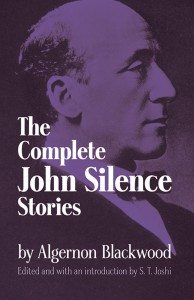 The Complete John Silence Stories
The Complete John Silence Stories
Algernon Blackwood
Dover Publications
November 2, 2011
Reviewed by Marvin P. Vernon
Of the traditional British writers of supernatural and ghost tales, I’ve always felt a kinship with Algernon Blackwood. He not only wrote some of the best supernatural fiction of the early 20th century but he wrote it like he “meant it.” It is a cliché to say his fiction did not evoke horror as much as awe, but it is a remarkably accurate description of the power of his writings. Blackwood was quite knowledgeable about the many mystic organizations and practices that were popular from the Victorian Age on and used that knowledge prodigiously. He had a great love and respect for the outdoors and appeared to have regarded the earth and its mysteries in an almost pantheistic way at times. He could also, when he wanted to, make the wonders of earth and the cosmos most terrifying. It is that mix of wonder and terror that made Blackwood one of the most unique of the early 20th century horror writers.
Of his many short stories, the two most influential were “The Wendigo” and “The Willows” and for good reason – they evoke the very mix of awe and terror I mentioned above. However, the author was also influential in presenting the idea of the psychic detective or, in John Silence’s case, the “Psychic Doctor,” into the modern horror repertoire. There is no doubt the character of Dr. John Silence owes some debt to an earlier and more famous non-psychic colleague, Sherlock Holmes. He bears some of the same attributes; a keen sense of observation, an obsession to detail, a somewhat haughty but caring attitude toward his clients and a few other traits, yet Silence has distinctive differences. He is a medical doctor that, due to his amassing of a fortune, devotes his time to his interest in psychic mysteries and often helps those in need. He seems to have an unlimited knowledge of the most esoteric and dangerous phenomena. Of the six tales he is featured in, there is an unusual amount of variety in the types of threats. Even the most known terrors to the horror reader, such as the werewolf in “The Camp of Dogs,” takes on a more metaphysical element.
Each story has a slightly different narrative and theme. The first one is “A Psychical Invasion” in which Silence fights off a psychic haunting brought on by cannabis use (I think there may be a hidden and outdated warning about Marijuana use here). The intriguing thing in this story is the doctor’s helpful assistants: his dog and cat! Unfortunately this is the only tale in which these two clever animals are featured. “Ancient Sorceries” is the least interesting story primarily because John Silence takes a passive role by simply being the listener while the narrator tells his tale. His “helpful” comments at the end seem a bit unnecessary for the narration. In “The Nemesis of Fire,” we meet the doctor’s assistant, Hubbard, who narrates two of the six tales. “The Nemesis of Fire” is an involved piece regarding a string of fires and unusual happenings around an old plantation. Not only is it my pick for the best John Silence story but ranks high in all of Blackwood’s fiction.
“Secret Worship” takes on a different tack as John Silence arrives late and almost as a passerby. A man is visiting his old childhood school and, fortunately for him, Silence is aware that things at the school have changed and the gentleman may be in serious trouble. The aforementioned “The Camp of the Dog” is my second favorite work in the collection and the other story narrated by the assistant Hubbard. It features a number of Blackwood’s typicalities; a love for the outdoors, a view of the terrors as a mystical (if not dangerous) wonder, and optimistic hope for human nature; it is sort of a love story. Finally, “A Victim of High Space” rounds out the collection. It was the last John Silence story to be published and feels a little different. Briefly (as it is the briefest of the tales), it involves a man trapped between two dimensions which the doctor is able to help in the confines of his own consulting room. It feels a little more Hodgson than Blackwood to me.
The John Silence stories were Blackwood’s first real success. Written in the first decade of the 20th century, they were followed by more atmospheric and, to me, more terrifying tales. For that reason, I find them hard to rate knowing the best is yet to come. Yet for any writer of his time, these were well developed and very entertaining works. Even in these early works, Blackwood seems already matured and set in his choice of genre and themes. For any fan of British supernatural literature, this is an essential collection.









Thanks for letting us know about this new edition. Blackwood remains unsurpassed as a master of evoking spectral dread and, of course, awe. Nothing—-as Blackwood knew—-is as terrifying as wild nature, and what we imagine lurks behind it.